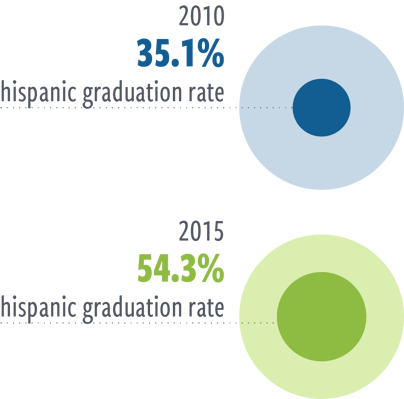
“CNM gives Hispanic mothers the opportunity to continue their careers in business. CNM has been a great support for me because it has allowed me to continue my studies, to make a career. I have had great support from instructors, from the coaches, and all of the staff. It is an excellent opportunity to enter the workforce.”
Hispanic and Native American support is nothing new for Central New Mexico Community College (CNM). In 2014-2015, these students earned 3,617 associate degrees and certificates and placed CNM as the No. 1 ranked college in the nation in the number of graduation awards earned by Hispanics and Native Americans. This focus has not halted and continues to be supported by implementing a student-friendly structure: the schedule.

In 2014-2015, CNM ranked No. 1 college in the nation in the number of graduation awards earned by Hispanics and Native Americans. Learn more about this award on their website.
On a college campus, each individual school often conducts business differently. Understanding that this was hindering student support, this community college adopted a more centralized approach to support departmental scheduling practices, increasing campus efficiency. Previously, course scheduling was done in isolation. Now, it is a more centrally supported, collaborative effort. When the goal is increasing degree attainment, structural pieces must be in place to support students, which is where centralized scheduling comes into play.
With senior leadership support, the Academic and Event Scheduling Department at CNM has leveraged data from Ad Astra’s strategic scheduling tools to evolve scheduling practices. This has birthed a new process that publishes a full-year academic schedule and enables students to plan the courses they will enroll in during the forthcoming terms. Using course demand projections and pathway section grids, the centralized scheduling department at CNM works closely with each department as they map out the volume and placement of core and general education courses to create optimal schedules for their students. Finally, CNM utilizes advanced registration monitoring tools to track registration trends and facilitate conversation across campus on key changes needed to meet shifting student demand throughout the registration cycle.
This shift to a one-time published schedule is called “Annualized Scheduling”, and it’s largely impacting students. Previously, students were completely altering their lives to accommodate semester-by-semester course schedules. Now, a schedule is set for a year. This new model is not only helping the traditional student; post-traditional students are seeing the benefits. By students knowing schedules a full year in advance, they can make accommodations. This halts the continuous, semester-by-semester life, work, and childcare scheduling shifts.
Focusing on the need for consistent schedules, CNM goes one step further in their annualized scheduling process. Customizing the schedule to meet student needs, they conduct an annual survey on student challenges related to course access and direct course conflicts, or conflicting personal obligations. In response, CNM has dedicated much time and energy to coordinating scheduling efforts that directly bear in mind these conflicts, so their students can receive student-centric schedules that support their lives and current availabilities.
Maria Zambrano, a student at CNM is seeing the fruit of these support structures. “CNM gives Hispanic mothers the opportunity to continue their careers in business. CNM has been a great support for me because it has allowed me to continue my studies, to make a career. I have had great support from instructors, from the coaches, and all of the staff. It is an excellent opportunity to enter the workforce.”
Entering the workforce is definitely a priority, as CNM has increased the number of students graduating since the inception of centralized scheduling practices. In fact, this college continues to lead the nation in the number of associate degrees and certificates awarded to Hispanics and Native Americans. Hispanic students, as the largest ethnicity served, are particularly noticing the benefits of this model.
From Fall 2010 to Fall 2015, Hispanic graduation rates steadily increased from 35.1% to 54.3%. It is important to note that this increase is specific to Hispanics. All other ethnicities, besides Asian students, have decreased graduation rates while Hispanic graduations trend upward. Retention rates are also increasing. From Fall 2016 to now, Hispanic retention increased from 60.7% to 67.4%.

Hispanic graduation rates grow and continue to increase.
The growth doesn’t stop with retention and graduation, additional enrollments are also a massive win. In an education climate with lowering enrollments, this college has managed to increase the number of credit-seeking Hispanic students. In 2018, enrollments from the previous year decreased 3.6%; however, for Hispanic students, enrollments increased by 1.4%. Again, this highlights the emphasis on catering to this demographic as Hispanic enrollment continually increases year after year.
With increasing metrics, it is not surprising that CNM was the No. 1 ranked college in the nation in the number of graduation awards earned by Hispanics and Native Americans and continues to rank No. 2 overall in graduation awards earned by this demographic. Institutionally, key scheduling shifts has helped bolster overall student success and have had a large impact on the Hispanic population. This trend is expected to continue as every year allows for additional optimizations to be made that help support this student demographic.

Ad Astra is higher education’s solution partner in managing the academic enterprise. Partnering with more than 500 colleges, universities, and systems nationwide, Ad Astra helps improve stewardship of instructional resources, streamline student access to courses, and accelerate student completions.